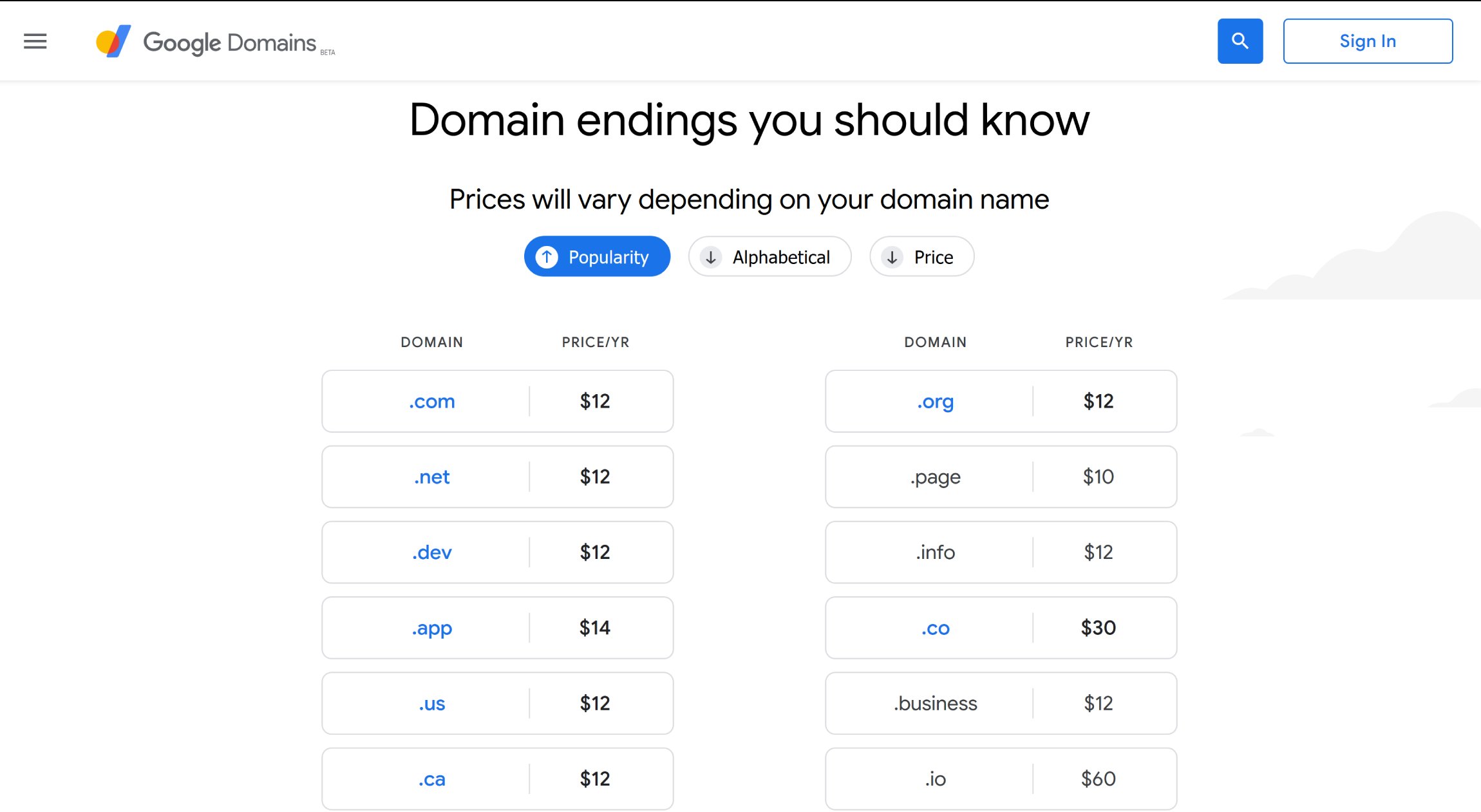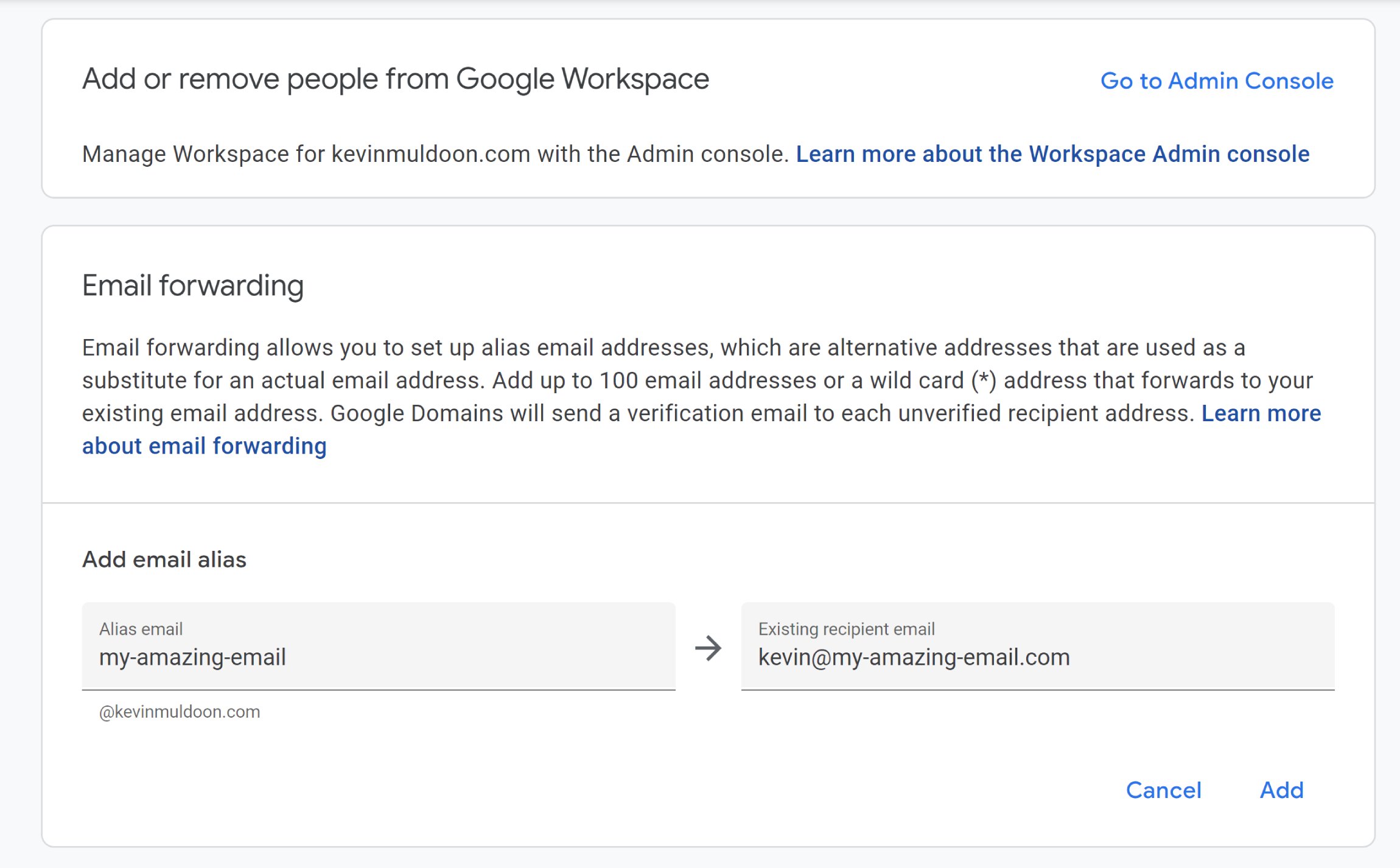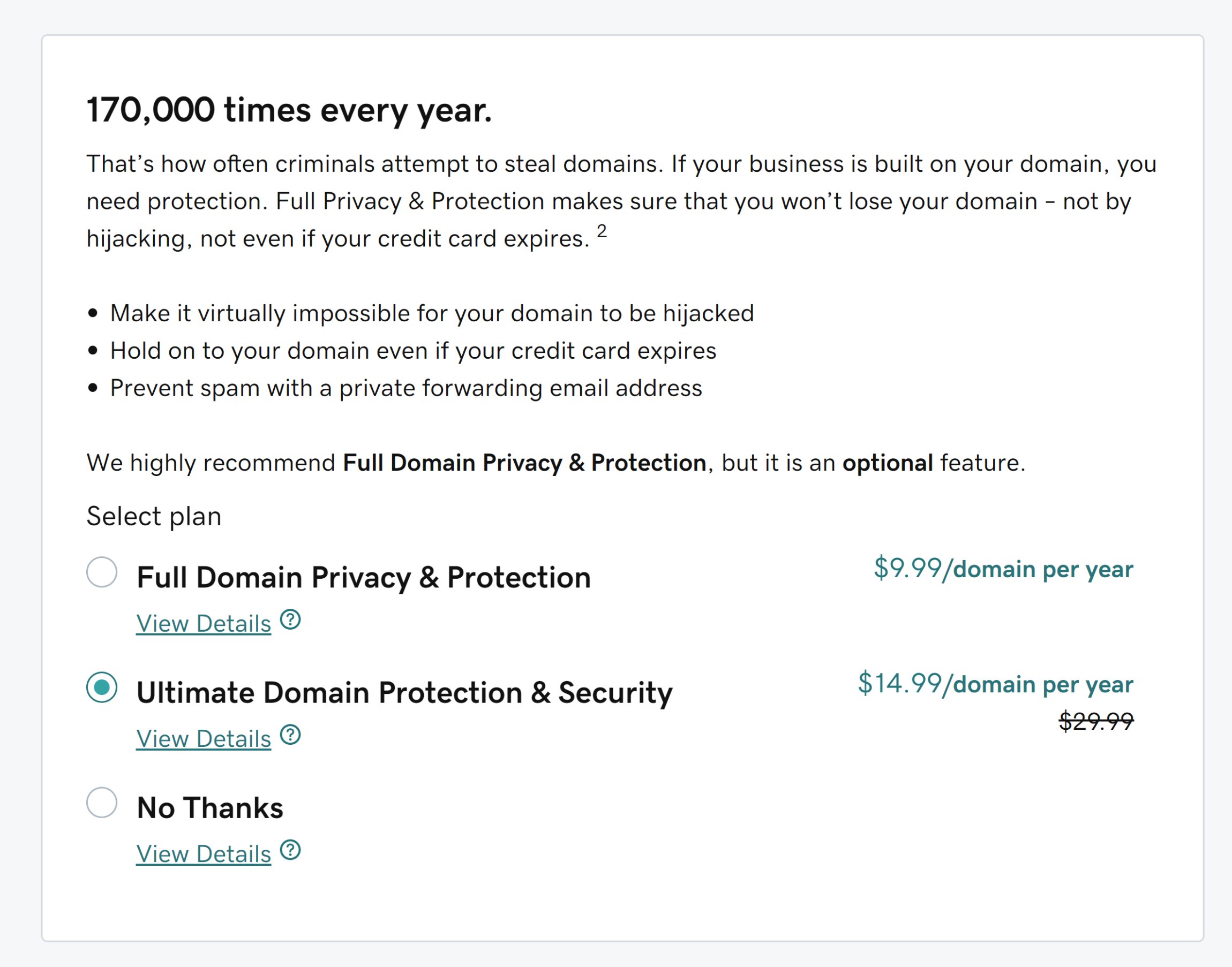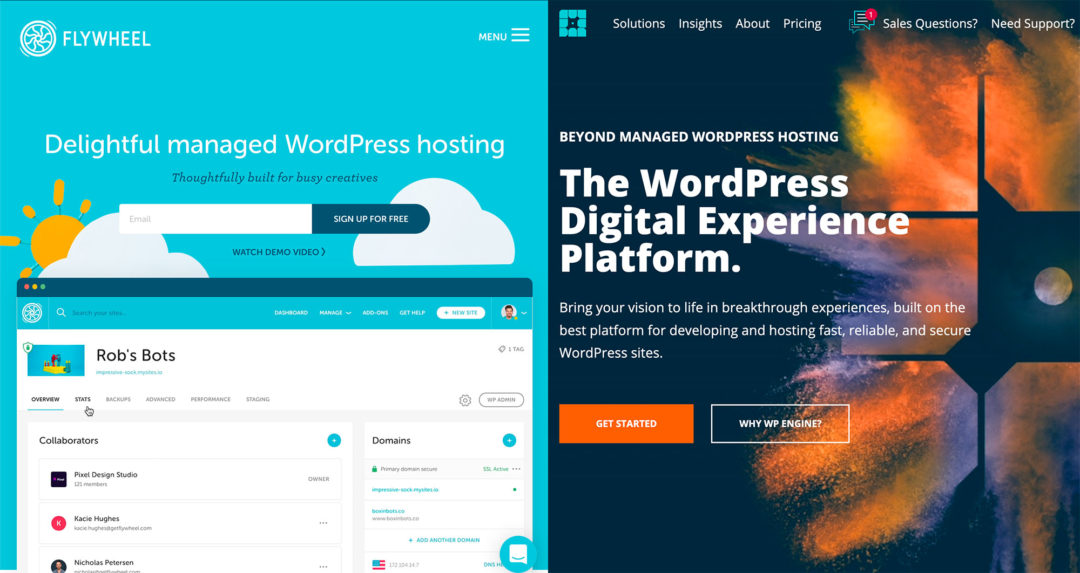An important part of building a website is not only choosing the right domain name, but also choosing the right company to register that domain name with. Unfortunately, because of the sheer number of domain registrars and domain reselling companies to choose from, this can be a daunting experience.
So, who should you register your domains with? Should you go with the company with the lowest fees for registrations or spend more to gain access to additional features?
To help you to better understand your options, here’s an in-depth look at both Google Domains and GoDaddy.
↪️ Note: For anyone looking to create a website specifically with WordPress, here’s another post of ours that might be of interest comparing the three officially recommended WordPress hosting providers: Bluehost, DreamHost and SiteGround.
Let’s see what these two domain registration services have to offer, and take a closer look at their functionality, features, pricing, and more.
Table of Contents
A Quick History of Google Domains & GoDaddy
GoDaddy is the largest domain name company and one of the longest-running domain registrars. In contrast, Google’s domain service has flown under many people’s radar: in part, because Google hasn’t been marketing it very aggressively (yet).
Although Google was founded in 1998, it didn’t launch its Google Domains service until 2015. The service was launched in beta mode and, several years later, Google still uses this beta tag in its branding.
While Google does have numerous services online, Google Domains solely focuses on domain registration and doesn’t sell any other services (though it does promote some affiliated website building companies).

In 1997, a year before Google was launched, Bob Parsons launched a domain registration company called Jomax Technologies. The company would be rebranded as GoDaddy in 1999, and, in 2005, it landed the title as the largest ICANN-accredited domain registrar in the world.

While Google Domain focuses solely on domain names, GoDaddy has always sold additional services to customers. It’s been incredibly successful at this, establishing itself as the largest website hosting company in 2018.
User-Interface & Ease of Use
If you’ve used a Google service, such as Google Analytics, Google AdWords or Google Search Console, you’ll feel right at home with Google Domains. It adopts the usual Google layout with a menu at the left-hand side of the page.
From the main menu, you can register new domains, see your registered domains, transfer a domain, access billing and get support. A host of additional configuration options are available when you select a domain.
I’ve used dozens of registration companies over the years, and Google Domains is by far the easiest to navigate and use. My only complaint is that making changes to multiple domains is time-consuming, as the bulk tool only allows you to renew multiple domain names. I was reminded of this recently when I moved house, as I had to manually update the registration address of all of my domains one by one.

GoDaddy was always known for its over-the-top branding, unnecessarily complex account area and multi-step checkout, where it pushed many other products and services to customers.
Thankfully, GoDaddy has cleaned up its act and adopted a minimal design that’s simple to navigate. The main account page lists all of the products and services you’ve purchased through GoDaddy, and, when you click on domains, you’ll be taken to an area where you can manage your domain and transfers, configure DNS settings, and purchase expired and premium domains.
Making bulk changes is much simpler in GoDaddy, and there are options to create DNS templates, import and export lists, group domains into folders, and delegate access to staff.

If you only have a couple of domains, Google Domains is generally quicker and easier to use. However, GoDaddy greatly simplifies the task of managing multiple domain names.
GoDaddy does continue to promote its other services when you register a domain name, but, thankfully, its upselling isn’t as invasive as it was previously.
🏆 Winner: GoDaddy
Domain Extensions Availability
Top-level domains, usually shortened to TLDs, refer to domain extensions such as .com, .net, .org, .co and more.
Google Domains supports more than 300 TLDs, and this total includes newer domain extensions such as .studio, .tech and .media.

At the time of writing, GoDaddy supported 499 domain extensions. However, a whopping 265 additional TLDs are scheduled to be added.

It’s difficult to choose an outright winner in this category as 99% of website owners will select a popular domain extension that’s available on both Google Domains and GoDaddy. However, there’s no disputing that GoDaddy offers customers a larger selection of TLDs.
🏆 Winner: GoDaddy
Email Forwarding
Email forwarding lets you create alias email addresses that are forwarded to your regular email address. Many online shops use email aliases for branding and marketing purposes, and large companies sometimes register a unique domain name specifically for support.
When you select one of your domains in Google Domains, you’ll see options to change registration settings, DNS settings and website configuration settings. You can also view traffic reports, adjust email settings and set up account security options.
Dedicated email accounts are handled through the Google Workspace service. However, Google Domains lets you create up to a hundred alias email addresses to be forwarded free of charge, all you have to do is enter the alias email address and the email address you want to forward correspondence to.

GoDaddy supports email forwarding too, but this is a service it charges for. Its email forwarding package costs $3 a year, and allows up to five alias email addresses to be forwarded.
🏆 Winner: Google Domains
Domain Privacy
Whenever you register a domain name, you need to supply details for the domain name’s Registrant, Technical and Administrative contact. For each contact, you need to provide a name, address, phone number and email address. This information is then added to domain WHOIS databases around the world.
You can and should use WHOIS privacy to prevent spammers and other unauthorised parties from seeing your personal contact information, and Google Domains allows you to protect your WHOIS privacy at the click of a button. All you have to do is enable privacy protection to hide your contact information.

GoDaddy also offers WHOIS privacy, but it charges an additional $9.99 a year for each domain. It also offers Ultimate Domain Protection & Security for $14.99 a year, which provides automatic malware scanning for your domain, and includes blacklist monitoring to ensure your domain doesn’t appear on any anti-spam blacklist.

While Google Domains and GoDaddy both allow you to hide your personal contact information, Google Domains is the clear winner here as it doesn’t charge you for it.
🏆 Winner: Google Domains
Domain Transfers
Domain names can be transferred to another registrar, as long as it’s not within 60 days of a registration or previous transfer. When a domain transfer is made, you need to add at least one more year of registration.
Historically, many domain name companies (particularly domain resellers such as website hosting companies) have made the process of transferring domains to them simple, but purposely made transferring domains out difficult by either charging a fee or making you contact them to initiate a transfer out. Thankfully, Google Domains and GoDaddy both handle domain transfers well and don’t charge a fee for transferring domains away.
In Google Domains, to transfer a domain name in, you simply enter the domain name, choose how many years of registration you want to add and then begin the process. To transfer a domain out, you need to go to the Registration Settings page for your domain, go to the Transfer Out section and generate an authorisation code for your new registrar.

Transferring a domain name to GoDaddy is straightforward, and, to encourage customers to transfer domains in, GoDaddy gives a discount on the registration extension fee. In other words: It’s cheaper to transfer a domain into GoDaddy than to register a new domain.
To transfer a domain away from GoDaddy, you simply go to the Domain Settings page, and, under Additional Settings, select to transfer your domain away.

Whether you choose Google Domains or GoDaddy as your domain registrar, you’ll have no problem transferring domains in or out.
🏆 Winner: Tie
Domain Pricing
Comparing the true cost of domain registrars can be difficult, as top-level domain fees vary so much. For example, you may find that a registrar charges less for .com registrations, but more for country code top-level domains such as .co. or .tv.
Additional features such as email forwarding and WHOIS privacy can influence costs too, but this isn’t something you need to worry about with Google Domains, as it’s adopted a no-nonsense approach to pricing.
The majority of domain extensions cost $12 a year with Google Domains, although some domain extensions, such as .fr and .page, only cost $10 a year, while others cost more. Google Domains charges the same fee when extending the registration period of a domain you’re transferring in.
All registrations come with additional features such as email forwarding and domain privacy free of charge.

GoDaddy’s use of discount codes and regular promotions has helped it to become the world’s most popular registrar, but it also makes calculating the true cost of the service difficult.
Its .com registrations are charged at $11.99 a year, but .net domains cost $14.99 a year, while local domain extensions tend to be cheaper. For example, .co.uk and .us domains only cost $0.99 the first year and then return to their usual price in the second year.
Costs start to rise quickly if you need additional features such as email forwarding and WHOIS privacy. If you require these features, a .com domain would cost $12 a year with Google Domains, but around $27 with GoDaddy.

GoDaddy is one of the cheapest domain registrars to transfer a domain in, but many additional costs arise if you want other features. Some domain extensions are cheaper in the first year, but costs increase sharply in subsequent years.
In contrast, Google Domain’s transparent pricing structure is fairer, cheaper and easier to understand.
🏆 Winner: Google Domains
Additional Services
The majority of domain registrars sell website hosting packages, online apps, security services and more. Google Domains is one of the few services that only sells domains. However, it does have a website building page that links to partner companies such as Wix, WordPress and Shopify.
While Google Domains has simplified the process of signing up to third-party companies, it’s merely a way for Google Domains to generate referrals.

GoDaddy offers a host of additional products and services to customers, including professional email accounts, website building, WordPress hosting, shared hosting, VPS hosting and dedicated servers. Hosting prices are competitive, starting from only $5.99 a month for a basic shared hosting package.
The company has also branched out into markets you might not expect, including Microsoft Office 365, online bookkeeping and even a service for adding a second phone number to your phone.

I don’t believe non-domain related services should be a factor when considering a domain registration company, but, if you’re a new website owner, you may find GoDaddy’s hosting and marketing services useful.
🏆 Winner: GoDaddy
Support
Support is another factor to consider when choosing a domain registrar: and something that should be a high priority if you haven’t registered domains before.
Google Domains provides support through email or an online chat box. Typically, the response time to queries posted through the chat box is less than five minutes. As I’ve worked online for years, this is sufficient for me as I rarely have to speak to Google about any configuration issues.
Google Domains has a large documentation area too that you can refer to if necessary, but it isn’t beginner-friendly.

GoDaddy has clearly made good support a priority. In addition to support documentation and an online chat box, it offers 24/7 telephone support and displays a telephone directory of GoDaddy call centres and opening times around the world.

Support is an area where Google Domains has to improve. Its chat response times are good, but telephone support isn’t available, and online documentation is quite poor. Therefore, if support is a priority to you, GoDaddy is by far the better option.
🏆 Winner: GoDaddy
Final Thoughts
As someone who has worked online for decades, I appreciate the transparent pricing structure and simple user-interface of Google Domains. GoDaddy can be more expensive when you factor in features such as privacy, but it’s undoubtedly the better option for beginners, as it provides telephone support. Its bulk-editing tools also reduce the time it takes to administrate multiple domains.
Here’s Where Each Service Shines
Google:
✅ User-friendly interface.
✅ Simple and competitive pricing structure.
✅ Email forwarding and WHOIS privacy included with registrations.
GoDaddy:
✅ Attractive discounts and domain transfer fees.
✅ Managing multiple domains is easy using bulk-edit tools.
✅ 24/7 telephone support.
^Main advantages of using each service.
Related Reading:
Used/using either of these two domain providers? Thoughts and experiences with each?
Discover more from WPMarmalade
Subscribe to get the latest posts sent to your email.






2 Comments
I’ve found GoDaddy unresponsive in transferring domains to a small hosting provider whose service personnel are excellent and very quick to respond to any of my technical needs. Some transfers from GoDaddy to this small hosting provider have not been completed, even after a very long wait. I’ve had a similar experience with Hostmonster.
GoDaddy has, however, been quite responsive when I’ve moved domains from GoDaddy to Google Domains. I’ve had no problems with these transfers.at all so far.
Thanks for share really helpful, according to my GoDaddy is the best and offers affordable domain names with beginner-friendly panels and help where google domains are somehow techy.